The Datura genus, often referred to by ominous names such as Devil’s Trumpet or Thorn Apple, is a group of plants renowned for their breathtaking beauty and perilous toxicity. While their trumpet-shaped flowers and spiny seed pods may add a dramatic flair to gardens, these plants are extremely dangerous to both humans and animals. This article delves into the world of Datura, exploring its species, risks, and why it’s essential to keep a safe distance from these toxic plants.
What Is the Datura Genus?
The Datura genus belongs to the Solanaceae family, commonly known as the nightshade family, and includes plants native to the Americas that have now spread across the globe. These hardy plants thrive in disturbed soils, roadsides, and even home gardens, where they are often mistakenly cultivated for their ornamental appeal.
Datura plants are easy to recognize by their large, trumpet-shaped flowers in hues of white, purple, or yellow, paired with spiny seed pods. Despite their alluring appearance, all parts of these plants are highly toxic, capable of causing severe harm even in small doses.
Common Species of Datura
Several species within the Datura genus are particularly noteworthy for their striking features and extreme toxicity.
Datura stramonium (Jimsonweed or Thorn Apple)
This species is identified by its white or purple trumpet-like flowers and distinctive spiky seed pods. Known for its hallucinogenic properties, even small amounts can lead to severe poisoning, making it one of the most dangerous plants in the genus.
Datura metel (Horn of Plenty)
Recognized for its large, showy flowers that come in white, yellow, or purple, Datura metel is often cultivated for ornamental purposes. Despite its use in Ayurvedic medicine, its misuse can result in highly dangerous consequences.
Datura inoxia (Moonflower)
This species is celebrated for its fragrant, white, night-blooming flowers, which are often confused with the harmless Moonflower vine. The seeds and flowers are rich in toxic alkaloids, making accidental poisoning a common occurrence.
Datura ferox (Long-spined Thorn Apple)
Known for its larger, spiny seed pods, this species contains some of the highest concentrations of harmful alkaloids. Its toxicity is among the most severe within the genus, posing a grave risk to humans and animals alike.
Toxic Compounds in Datura Plants
All species of Datura contain potent tropane alkaloids, including atropine, scopolamine, and hyoscyamine. These substances disrupt the central nervous system and can cause severe, life-threatening symptoms. Even minor exposure—through ingestion, inhalation, or skin contact—can lead to poisoning.
Symptoms of Datura Poisoning
Datura poisoning manifests through a range of alarming symptoms, including:
- Hallucinations and Delirium: Often vivid and terrifying, hallucinations are a hallmark of Datura toxicity.
- Dilated Pupils and Blurred Vision: These symptoms result from the plant’s toxic effects on the nervous system.
- Dry Mouth and Difficulty Swallowing: A common sign of atropine poisoning.
- Increased Heart Rate and Blood Pressure: These effects can escalate to dangerous cardiovascular complications.
- Seizures and Coma: In severe cases, poisoning can lead to respiratory failure, coma, or even death.
Why You Should Avoid Datura
The dangers of Datura cannot be overstated. Its extreme toxicity and unpredictable effects make it a plant to avoid at all costs.
- Highly Toxic Even in Small Quantities: Consuming just a few seeds or a small portion of the plant can trigger severe symptoms, making accidental poisoning a significant risk.
- Unpredictable Alkaloid Concentrations: The levels of toxic compounds vary between plants and even within parts of the same plant, making their effects unpredictable and extremely dangerous.
- Threat to Animals: Datura is highly toxic to pets and livestock. Even minimal exposure can be fatal, making it essential to ensure these plants are not accessible to animals.
How to Stay Safe Around Datura

To protect yourself, your family, and your pets from the dangers of Datura, it is crucial to take preventative measures.
- Avoid Touching or Handling: Even handling the plant can expose you to its toxic compounds through your skin.
- Keep Away from Children and Pets: The colorful flowers and spiny seed pods may attract curiosity, but they are lethal.
- Wear Protective Gear: If removal is necessary, always wear gloves and protective clothing to minimize direct contact.
- Educate Others: Share information about the plant’s risks to help prevent accidental exposure or ingestion.
What to Do in Case of Datura Poisoning
If you suspect Datura poisoning, seek immediate medical attention. Time is critical, as the plant’s toxic effects can escalate quickly. Emergency responders need to know the source of poisoning to administer the appropriate treatment.
A Word of Caution
While Datura plants are undeniably beautiful, their toxic properties far outweigh their ornamental appeal. Avoid cultivating or handling them, and educate others about their risks. If you encounter a Datura plant, it’s best to admire it from a safe distance and leave it undisturbed. Remember, safety always comes first when dealing with such highly toxic plants.
Disclaimer
This article is for informational purposes only and should not be considered medical advice. If poisoning is suspected, contact emergency medical services immediately.
Share this information with friends and family to help spread awareness about the dangers of Datura plants. Awareness is the first step toward prevention.


